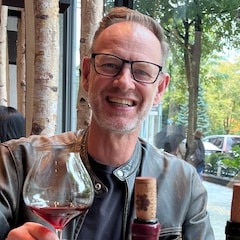Savoring Shizuoka: A Gourmet Adventure
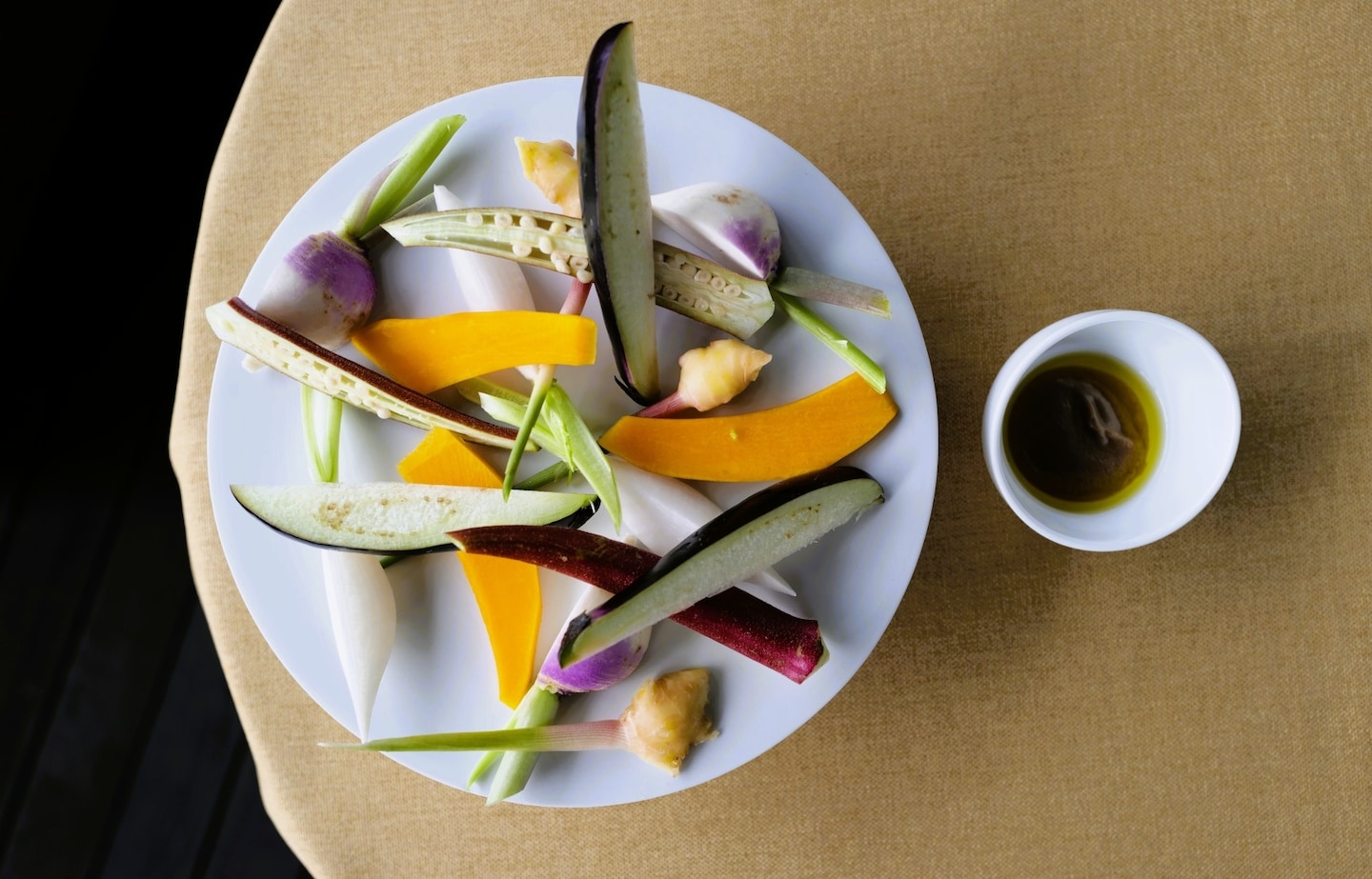
A short distance south of Tokyo, Shizuoka Prefecture is earning a reputation as a luxury destination for travelers in search of unique accommodations and culinary discoveries. Andrew Lee shares some of the prefecture’s highlights.
By Andrew Lee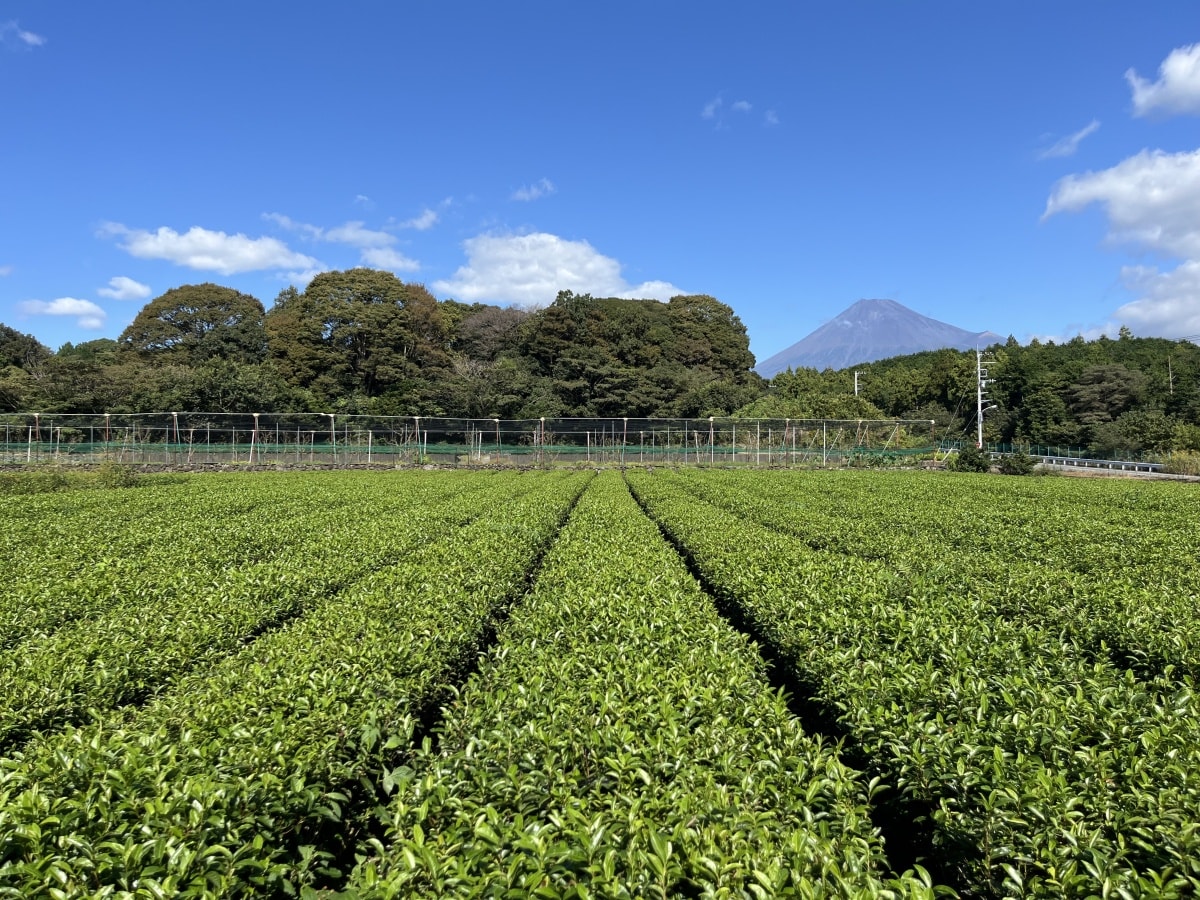
Shizuoka is famous for it’s tea and the green rows of tea plantations make for a striking location from which to see Mt. Fuji.
I was sure Mt. Fuji was stalking us. One minute, it was looming on our right, then it was suddenly gone, vanishing behind trees as our car wound through the lush forests of the Izu Peninsula. We rounded a bend, and its iconic peak was there again, somehow in front of us. I snapped a quick photo with my phone before it slipped away. My hosts seemed relieved: the weather was cooperating, and Fuji-san was putting on a good show.
We were driving through Shizuoka Prefecture, where I had been invited by the region’s tourism board, eager to showcase the natural beauty and outstanding produce of their home. As Japan’s tallest mountain came into view again on one side, a glimmering stretch of water appeared on the other. It was Suruga Bay, the country’s deepest bay, renowned for its seafood—which I was soon to taste.
The purpose of the tour was to experience what Shizuoka has to offer affluent gourmet travelers. Over the course of three days, I was treated to extraordinary meals, including a bespoke lunch served among the rows of a tea plantation and an exquisite dinner at a secluded auberge deep in the forest. Along the way, I also got to visit local producers—wasabi growers, farmers, and tea masters—and meet chefs shaping Shizuoka’s reputation as a dining destination.
We began by the ocean, in the onsen resort town of Atami.
Aloha Atami: Art, Sweets, and Superb Seafood
The entrance tunnel to the MOA museum of art in Atami is 200 meters long and features an illuminated passageway with 7 escalators.
Atami station was absolutely packed when I got off the Shinkansen. I shouldn’t have been surprised; it was a Sunday, and Atami is a popular day trip for inbound tourists and Japanese alike. During the “bubble,” Japan’s economic boom in the 1970s and ’80s, Atami was a favorite weekend getaway for Tokyoites—even given the nickname “Japan’s Hawaii.” But I’d heard the town had since fallen on hard times, so the sheer number of people waiting for buses and taxis was a bit of a shock.
Luckily, there was a private car waiting for me, and our first stop was the MOA Museum of Art, perched high above the town. As we drove up the steep road to the museum, the hills were dotted with bubble-era apartment buildings and hotels.
The MOA itself was built in 1982 and renovated in 2017. It’s a private museum open to the public, housing a collection of traditional Japanese arts and crafts, including several National Treasures and works designated as Important Cultural Properties. From its lower entrance, seven flights of escalators take visitors up an illuminated tunnel 200 meters long to the impressive main building. The terrace in front features a sculpture by English artist Henry Moore and has a panoramic view of Sagami Bay and the narrow streets of Atami’s main tourist area, where we were headed next.
As Atami shakes off decades of decline, its shotengai (shopping streets) are once again buzzing with visitors drawn to the town’s retro charm and its newfound reputation as a dining destination. Much of this resurgence seems to be due to social media, as local cafes and shops embrace the power of Instagram. Sweets, in particular, seem popular, judging by the lines of young women outside shops specializing in towering parfaits, delicate puddings, and artisanal donuts. I offered to take a photo of one group with their dessert, but selfies are preferred these days, it seems, as they quickly captured the perfect shot to upload, #atamisweets.
The Instagram crowd is the target audience for Atami now, and both places I visited had particularly photogenic treats: Maison de Parfait Juzen Jubi, with brightly colored fruit parfaits and an alcohol pairing course; and Wagurigashi Kiito, with its “raw silk” Mont Blanc made from unsweetened Japanese chestnuts, delicately squeezed (while you watch) into a pile of noodle-like strands resembling a cute furry animal of some kind. “Insta-bae!”
Sweet shops, such as Maison de Parfait Juzen Jubi, in Atami create deliciously photogenic desserts worth sharing on social media.
Unsweetened chestnuts are squeezed into fine “noodles” at Wagurigashi Kiito, a Mont Blanc shop popular with young women who upload photos to their Instagram.
Thankfully, Atami has more to offer hungry travelers than just sweets, and our next stop was Acao Forest, a short drive along the coast.
Perched on a hill with sweeping views of Sagami Bay, the resort features numerous art installations and a stunning rose garden. Next to the garden is Coeda House, a cafe designed by renowned architect Kengo Kuma. The building’s roof is supported by a striking pillar of interlocked wooden blocks, reminiscent of an unfinished game of Jenga, surrounded by glass walls that provide a panoramic view of the bay. It’s an ideal spot to relax with a coffee or a glass of champagne while taking in the ocean scenery.
Coeda House designed by renowned architect Kengo Kuma offers amazing views of the ocean.
The resort also features Restaurant Not A Gallery, which offers discerning guests a private, customized dinner, showcasing the best local produce from around Shizuoka, including fresh fish from Sagami Bay and other regional specialties.
On my visit, the chef Tomoyuki Kikuta greeted us with a chilled wagon displaying the raw ingredients he would be using for the main dishes, including fresh madai (sea bream) and kinmedai (splendid alfonsino), aged kuroge wagyu (beef), and hunted inoshishi (wild boar).
After choosing our mains, the waitstaff brought out table-length wooden trays piled high with crispy raw vegetables topped with slices of succulent trout and venison. Dishes such as roll-it-yourself beef sushi, steamed awabi (abalone), and pumpkin soup followed, before the mains we had selected arrived. I had chosen the grilled kinmedai, it’s crispy orange skin and moist white meat complimented by a savory onion sauce. The beef and boar my companions had selected looked equally outstanding. Despite the venue’s name, the whole meal was indeed worthy of a gallery.
* Dining at Restaurant Not A Gallery is by appointment only.
At Restaurant Not A Gallery guest can choose their mains from a display the of fresh local produce.
Long trays of raw vegetables are artfully displayed on the table at Restaurant Not A Gallery.
For my main I had kinmedai (splendid alfonsino), it’s crispy orange skin and moist white meat complimented by a savory onion sauce.
Deep in Izu’s Forest: The Luxury of Doing Nothing
Auberge Resort Arcana Izu is hidden among the trees in central Izu and offers discreet modern luxury for discerning guests.
Atami is often the first stop for visitors to Shizuoka’s Izu Peninsula, which extends south between Sagami Bay on its east and Suruga Bay on its west. While it’s known for dramatic coastlines and white sandy beaches, we were headed to the peninsula’s mountainous interior.
Hidden in the forests of central Izu, Auberge Resort Arcana Izu offers a peaceful escape for visitors looking for some private downtime. On arrival, I was welcomed by the hotel’s friendly butler. No public reception area here–-he discreetly escorted me to my room to check in while I relaxed on the sofa.
Each of the sixteen guest rooms is designed to offer a sense of calm and a connection with nature, with views of the forest and river outside. A private outdoor onsen waits on the balcony, with water flowing directly from a hot spring source. There is no TV in the room, and guests are encouraged to unplug and unwind with board games or by listening to the CDs provided with the audio player. Sometimes simply doing nothing is all the luxury you need.
Each of the luxurious rooms at Auberge Resort Arcana Izu feature outdoor onsens where you can relax with a view of the lush forest.
True to its description as an auberge, dinner and breakfast are naturally included, and they are served in the resort’s splendid dining room, where each seat faces the stage-like kitchen. Here, chef Yuma Itoi works before a massive window that frames the lush garden beyond, creating a sense of theater as we watch him prepare his “Emotional French” cuisine. Local produce is the focus, with dishes featuring ingredients such as ayu (sweetfish) and freshwater crab from the river nearby, sansai (mountain vegetables), wild deer from Izu’s Amagi mountain range, and, of course, wasabi, which was first cultivated in Shizuoka 400 years ago.
In the dining room of Arcana Izu, Chef Yuma Itoi works before a dramatic window that frames the garden outside.
All the ingredients used at Arcana Izu come from Shizuoka, such as this shitabirame (a kind of sole) from Suruga Bay, served with a pumpkin puree and fig.
As a side trip from Arcana Izu, it is worth taking a 20-minute drive to Shimoyama Amago and Wasabi Farm, one of the local producers chef Itoi works with. There I had the opportunity to harvest my own fresh wasabi from the natural spring waters that flow through the farm. The friendly owner, Akira Shimoyama, made sure I knew the correct way to grate it. “Make sure you do it clockwise,” he said, smiling. “And laugh while you do it!”
At Shimoyama Amago and Wasabi Farm, the owner, Akira Shimoyama, shows how to harvest the fresh wasabi his family has been growing in the area for 60 years.
Shimoyama Amago and Wasabi Farm is the only place in Japan that raises amago (red spotted trout) so fresh it can be eaten as sashimi.
Shimoyama’s family has been growing wasabi here for 60 years, and it’s also the only farm in Japan cultivating amago (red spotted trout) so fresh it can be eaten as sashimi—which we did, with the wasabi, of course.
Dining with the Master: Al Fresco at a Tea Plantation
Tea master Mohei Honda teaches guests how to harvest fresh tea leaves.
Dining outdoors on a gorgeous summer day is always pleasant. But when lunch is served among the vibrant green rows of a tea plantation, under a blue sky, with a view of Mt. Fuji on one side and Sagami Bay on the other, it is a truly rare experience.
For five generations, tea master Mohei Honda’s family has been producing tea in Shizuoka. Honda, chairman of the Association of the 100 Best Teas of Shizuoka, is a passionate educator on traditional Japanese tea culture. He also offers tours where visitors can experience picking tea at his plantation and visit his family’s roastery to learn the difference between sencha, gyokuro, and hojicha.
Honda has recently been collaborating with chef Shingo Hosaki of Sinq restaurant in Shizuoka City to create exceptional food and tea pairing events under the name TenZumi. I was lucky enough to attend one such meal outside on the simple wooden “chanoma” (tea terrace) Honda had built at his plantation beneath Mt. Fuji.
While sitting at a low table on tatami laid out on the chanoma, tea master Honda made and served us tea, pairing each course that chef Hosaki prepared with a different kind of tea or tea-infused spirit. Hosaki’s restaurant is known for sumibiyaki (charcoal grilling), aged meats, and various fermentation techniques, but for these events, chabayaki (tea-leaf grilling) and the tea-smoked ingredients are the stars.
Our lunch started with fujinotori (a local chicken breed), grilled and smoked over tea leaves, served skewered on a tea twig with plump shine muscat grapes, and paired with a warm aromatic white tea. It was followed by aged shima-aji (striped horse mackerel) from Sagami Bay, lightly seared to enhance its umami, with charcoal-grilled potatoes and salt-pickled sarunashi (a wild mini kiwi), paired with cold-brewed sencha or sencha-infused rum.
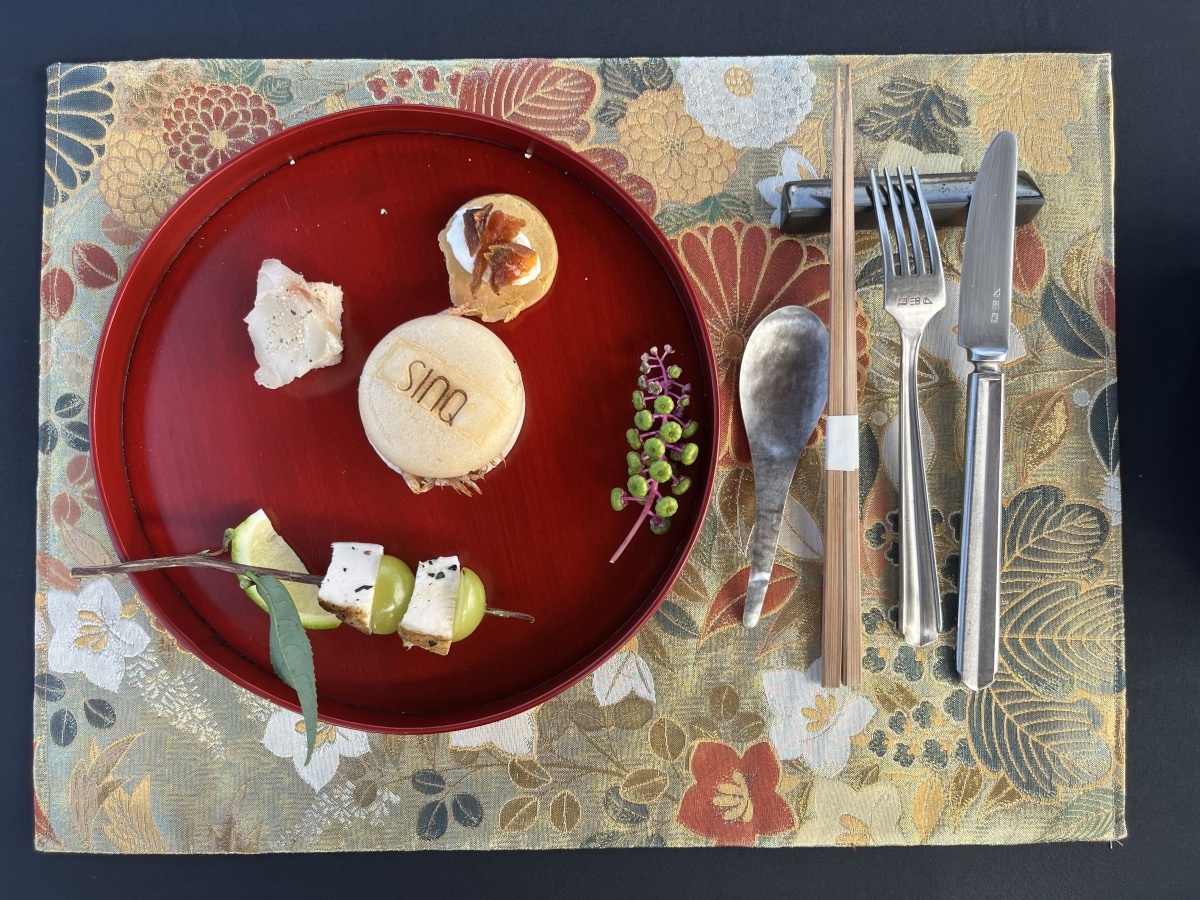
Lunch started with fujidori (a local chicken breed), grilled and smoked over tea leaves, served skewered on a tea twig with plump shine muscat grapes, with the signature monaka wafers of chef Shingo Hosaki of Sinq restaurant.
The standout was Honda’s pairing of marubi hojicha and tea-infused brown-sugar shochu with tender Fujinomiya pork loin, smoked over the tea leaves we’d hand-picked prior to the meal. Juicy, inch-thick slabs of the meat were served with Hosaki’s venison-based soy sauce, and the drinks complimented it all perfectly, the tannin of the tea and alcohol of the shochu cutting right through the fat, which in-turn offset the astringency and bitterness of the tea. It tasted incredible.
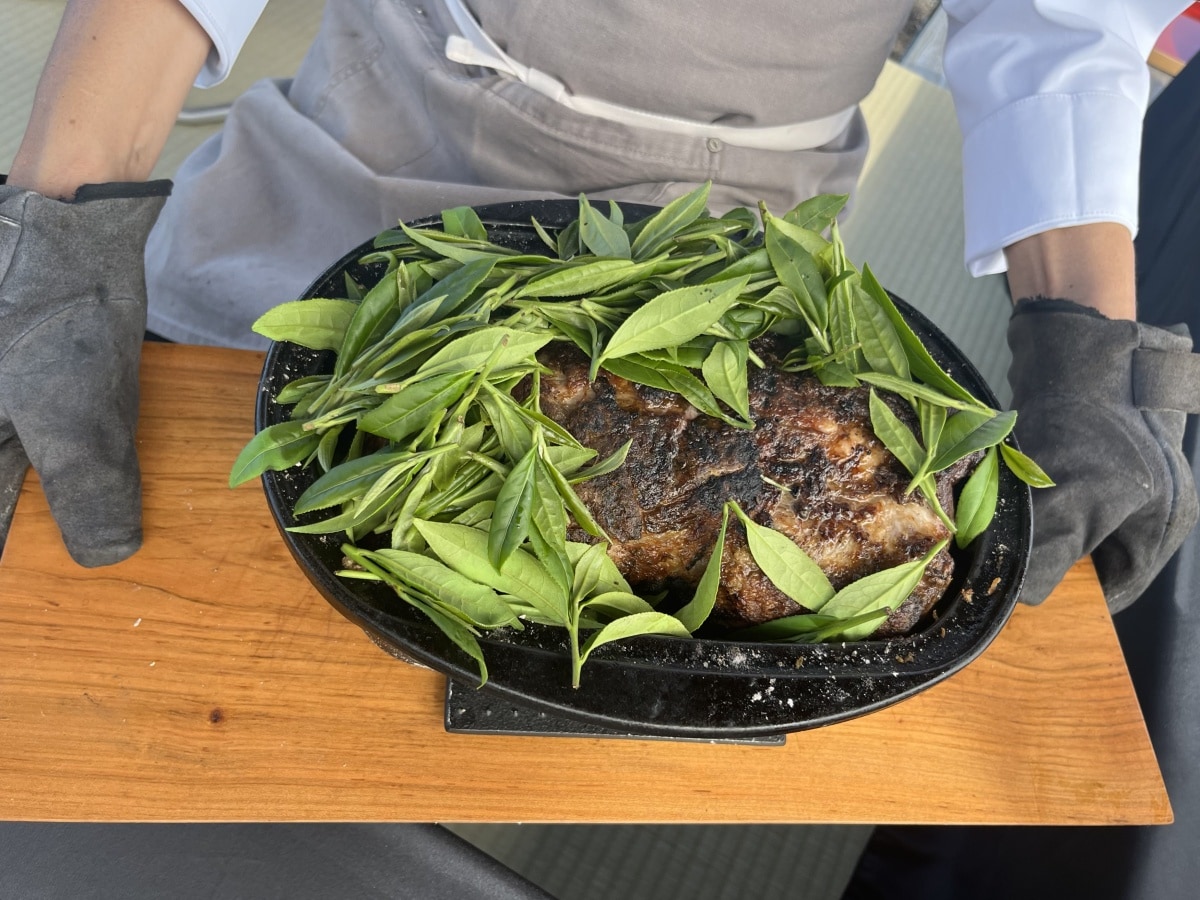
Tender Fujinomiya pork loin, smoked over tea leaves hand-picked by guests.
This mouth-watering dish was followed by a yaki-onigiri (grilled rice ball) in a rich peanut miso soup with pickled tea leaves that was the ideal end to one of the most memorable meals I have ever had.
Tea master Mohei Honda (right) has recently teamed up with chef Shingo Hosaki of Sinq restaurant in Shizuoka City to create exceptional food and tea pairing events under the name TenZumi.
Viva L’Italia: At the Foot of Mt. Fuji
Sakura Kagami’s executive chef, Toru Kuroha, stumbled into Italian cuisine by chance.
Gotemba, just east of Mt. Fuji, is generally associated with the premium outlet mall that attracts busloads of bargain hunters each day. Nearby, at Ristorante Sakura Kagami, however, the on-site helipad suggests a more exclusive clientele. Located on a private estate beside the Chichibunomiya Memorial Park, Sakura Kagami offers a luxurious dining experience with (another) simply breathtaking view of Mt. Fuji. This was the location for the final meal of our trip.
In the kitchen at Sakura Kagami, chef Toru Kuroha works with his staff to create exquisite Italian cuisine from local produce from around Shizuoka.
The restaurant’s executive chef, Toru Kuroha, bases his menu on traditional Italian cuisine, and during lunch, he took a break from the kitchen to describe to me how he stumbled into Italian cuisine almost by accident. “In my mid-twenties, I was running a French restaurant in Setagaya, Tokyo, but the business wasn’t going so well,” he says. “So one day I tried spaghetti, and it was a hit! And I thought, ‘Okay, I need to study this properly.’”
At 27, Kuroha (who is now 56) moved to Italy and worked his way across the country, first in Bologna, then Piedmont and elsewhere. He says the seafood dishes of Sicily and Tuscany most influence his cooking today, and fish from Suruga Bay features heavily on his menu at Sakura Kagami.
Toward the end of his six years in Italy, Kuroha saw a TV program about El Bulli, at the time the world’s top restaurant. “I became interested in working there,” he says. “For some reason, I had a Japanese calligraphy brush with me in Italy,” he says laughing. “So I wrote a letter to Ferran Adrià with it.” It must have impressed the legendary chef, for soon after, Kuroha was invited to be the first Japanese person to train at El Bulli, where he stayed for a year.
In 2001, Kuroha returned to Japan and became executive chef for various Italian restaurants in Shizuoka before coming to Sakura Kagami in 2020.
One of the lessons Kuroha brought back from his time in Europe was the importance of working with local producers. For the past twenty years or so he has worked with Sugisho Farm in Mishima, who supply his vegetables and are known for their gochisou nasu variety of eggplant that is fresh and sweet enough to eat raw.
Earlier in the day, we’d visited the farm and tasted the eggplant fresh off the vine. At Sakura Kagami, Kuroha served it as an appetizer, accompanied by a selection of the farm’s other vegetables and a bagna cauda sauce. Other notable dishes on the menu that featured Shizuoka’s produce included Suruga Bay aji (horse mackerel) fried in batter and served with serrano ham and sikuasa lime; linguine with doumangani, a mangrove crab from Southern Izu; and shoulder roast mugi buta (barley-fed pork) from Mt. Ashitaka, with Shizuoka wasabi, watercress sauce and a marsala reduction.
The gochisou nasu variety of eggplant from Sugisho Farm in Mishima, is fresh and sweet enough to eat raw from the vine.
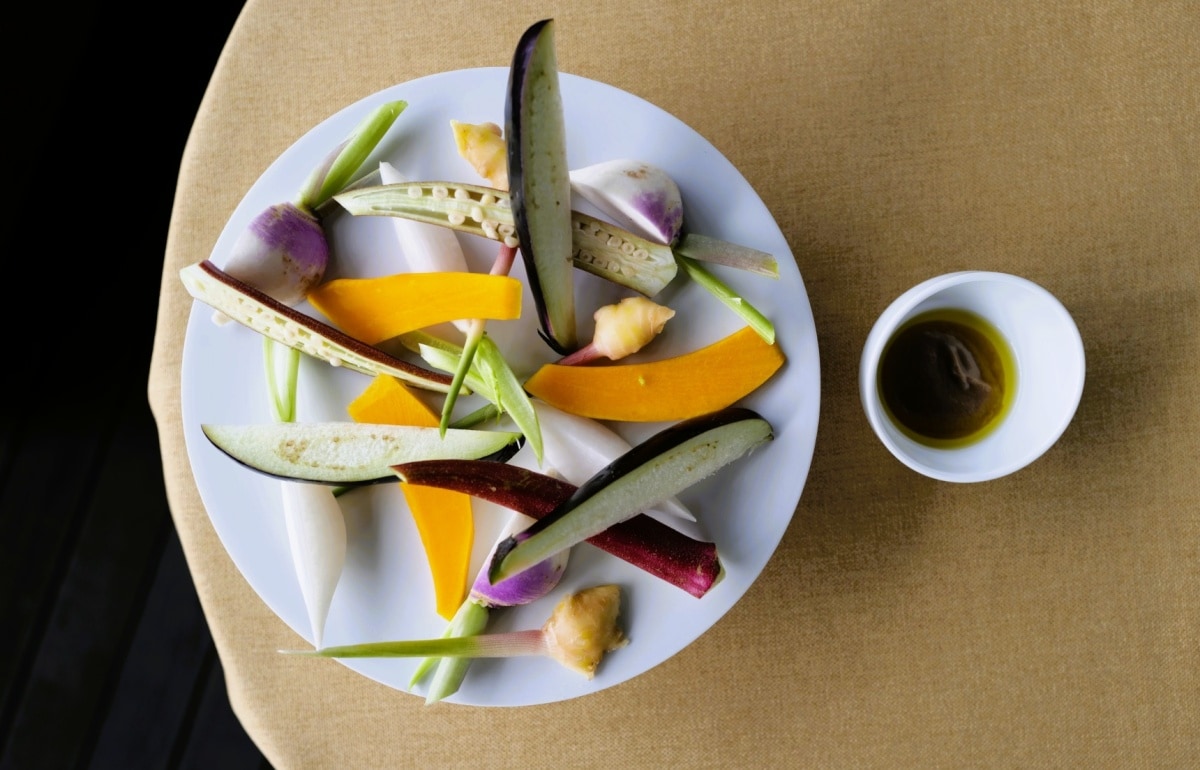
At Sakura Kagami, Sugisho Farm’s gochisou nasu is served raw with other vegetables and a bagna cauda sauce.
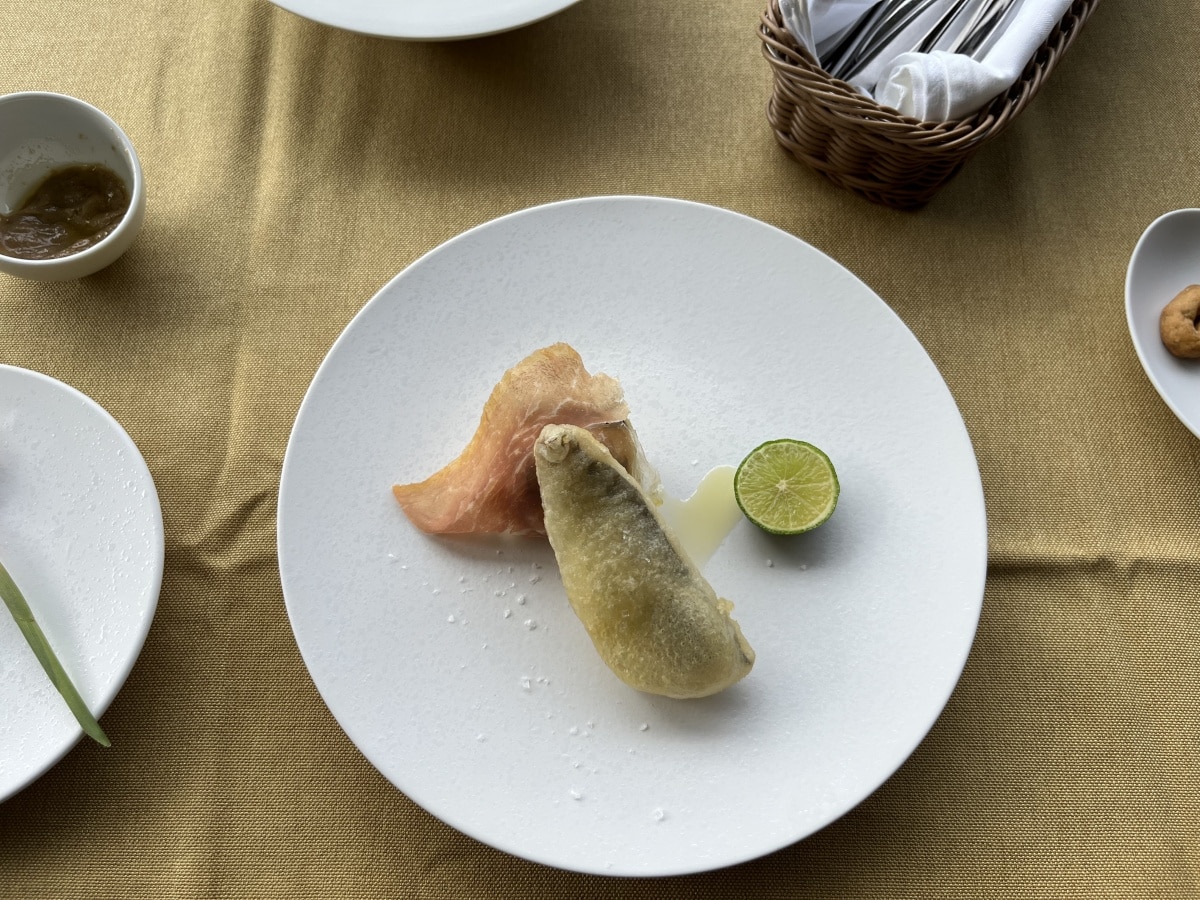
Suruga Bay aji (horse mackerel) fried in batter and served with serrano ham and sikuasa lime.
After three days of fine dining I was little concerned this final lunch may have been a disappointment. I needn’t have worried, Kuroha brought the best out of every ingredient with incredible finesse, proving again how good the produce is in Shizuoka. It’s no surprise customers fly in by helicopter just to dine at Sakura Kagami.
Overall, the time I spent in Shizuoka recently was a revelation. Like many people I’ve often sped through the region on the Shinkansen on my way elsewhere, but I’d rarely stayed a night or dined out here, which is a shame, really. If my short trip was any indication, Shizuoka is clearly worth exploring further, especially for those of us who love good food. Some of Japan’s best restaurants are hidden within its borders, and the seafood in particular is unmatched. In the west there is the port town of Yaizu, which is becoming known for its high end fish restaurants, and on Izu Peninsula’s southeast coast there are the white beaches of Shimoda on which to relax in summer. While in the heart of Izu, not far from Arcana, there is Shuzenji, one of Shizuoka’s oldest and most charming onsen towns. And, after all is said, it’s hard to grow tired of that mountain following you around every corner.


